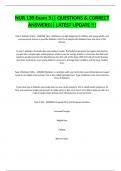Exam (elaborations)
NUR 130 Exam 5|| QUESTIONS & CORRECT ANSWERS|| LATEST UPDATE !!!
- Course
- Institution
Type 1 Diabetes Patho - ANSWER Type 1 diabetes is usually diagnosed in children and young adults, and was previously known as juvenile diabetes. Only 5% of people with diabetes have this form of the disease. In type 1 diabetes, the body does not produce insulin. The body breaks down the sugars a...
[Show more]



